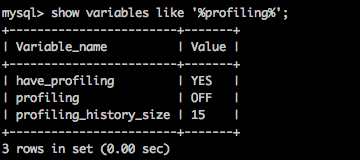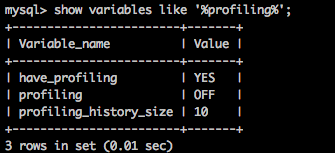概述
PROFILE 可以跟踪查询语句各个阶段 Time,IO,CPU,MEMORY 等资源使用情况,比较详细。所以系统一般不会记录太多。启用是全局的,所以每个连接都保持语句的资源使用情况。
The SHOW PROFILE and SHOW PROFILES statements display profiling information that indicates resource usage for statements executed during the course of the current session.
1、查看 PROFILE 是否启用
mysql> select @@profiling; mysql> show variables like '%profiling%';

have_profiling :是否可使用 profilingprofiling :是否启用profiling_history_size : 保留最近执行的记录数量。默认15,最大100,0相当于禁用。
2、启用profile(为全局变量)
mysql> set profiling = 1; mysql> set profiling_history_size = 10;

3、查看当前连接最近执行语句情况,编号越大为当前最近执行的
mysql> show profiles;
4、查看以上查询开销:SHOW PROFILE Syntax
SHOW PROFILE [type [, type] ... ] [FOR QUERY n] [LIMIT row_count [OFFSET offset]] type: ALL | BLOCK IO | CONTEXT SWITCHES | CPU | IPC | MEMORY | PAGE FAULTS | SOURCE | SWAPS
默认显示时间信息,显示了该查询从开始到被清除各个阶段的执行时间。
mysql> show profile;
其他查看方法:
mysql> show profile; #默认显示时间信息 mysql> show profile CPU,BLOCK IO; #(时间)加上 CPU,BLOCK IO 使用情况 mysql> show profile for query 6; #query_id=6的(时间)信息 mysql> show profile CPU for query 6; #query_id=6的cpu信息 mysql> show profile CPU limit 6; #前6个状态信息(前6行) mysql> show profile CPU limit 6 offset 2;#第2行起前6个状态信息(前2~7行)
5、关闭跟踪
set profiling = 0; set profiling_history_size = 0;



 浙公网安备 33010602011771号
浙公网安备 33010602011771号